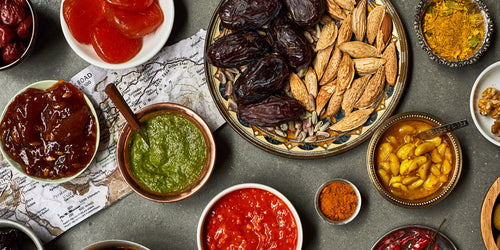Your Cart is Empty
Have you ever devoted two consecutive thoughts to rice pudding? I haven’t. Rice pudding exists—at grandma’s, diners, curry houses. You eat it because it’s there. Then you move on to something more interesting, or another aspect of the holiday gathering that summoned the pudding in the first place. And that’s it—your time contemplating rice pudding is over.
Not that there’s anything wrong with rice pudding! It’s good. Okay, it’s fine. It’s easy to make and eat and digest. The saltine cracker of sweets.
But chef Chintan Pandya is starting to change my mind. I have spent weeks thinking about his magnificent rice pudding at Adda in Long Island City, a restaurant currently serving some of the most exciting Indian food in New York. Rave reviews from the likes of the New York Times and New Yorker are what sent me there one frigid night, and while his goat biryani and homemade paneer deserve every ounce of the praise they’ve received, nothing captured my attention more than his kheer, an assuming bowl of rice pudding adorned with a modest dusting of chopped pistachios.
Pandya’s rice pudding is a sweet risotto: so thick that you can sculpt it with your spoon, yet not at all stodgy or heavy. Each grain of rice retains its own singular toothsomeness, yet the gently toasted milk is heady with the fragrance of quality basmati.
Rice pudding is as simple as desserts come, but it takes real skill to pull off one as well designed as this. Inferior puddings, cooked with less patience and attention, turn unappealingly starchy from overcooked rice, and never achieve a true union of their core elements, rice and milk. So what does Pandya do differently?
The chef understandably didn’t want to divulge too many secrets, but he admitted this much: “It’s just milk, rice, and sugar. That's it.” But whole-fat milk is non-negotiable, he said, and quality rice is a necessity. Pandya insists on a long-grain rice like basmati. If it doesn’t smell good when you bring a handful to your nose, it won’t make magical pudding.
He also takes his pudding slow—painfully slow. “We put the pot [over a diffuser] on very low flame and cook the rice and milk slowly for four hours,” he went on, “then add add sugar and cook another two hours. We have a rule in the kitchen that every time someone walks by the pot, they have to stir it.”
This is a classic way to make Indian rice pudding, called kheer in the northern part of the country and payasam in the south. The terms actually refer less to the rice than the dairy. Slowly reducing a volume of milk by half or even more renders a thin liquid into a supple sauce, while the ever-so-gentle direct flame browns its proteins and sugars into a kind of caramel, which adds considerable flavor to the finished dessert. With kheer or payasam, rice is only one of the starchy possibilities; it can also be fortified with vermicelli noodles, bulgur, tapioca pearls, or any combination thereof. The dessert is so beloved in India that it’s made for holidays and festivals; fancy versions might be enriched with ghee, perfumed with spices, and colored tawny by the addition of raw sugar.
Inspired by chef Pandya’s minimalist kheer, I bought a fresh bag of basmati and cleared my calendar to test batch after batch of my own.
In previous pudding attempts, I never bothered to rinse the rice grains before cooking them in milk. (Rice pudding is a lazy, easy dessert, right?!) This time I bothered, and I’m glad I did; washing away the surface starch makes for a lighter, cleaner sauce that tastes more like rice and milk and less like glue and mediocrity.
Because I don’t work in a restaurant, I don’t have a heat diffuser like chef Pandya does, nor the time or staff to keep an eye on a vat of simmering pudding for six hours. I do, however, have some nice heavy-bottomed pans, which I quickly learned are necessary to keep the pudding from burning over an extended cooking time, even on low heat. If you own one, a clay pot is your best option, as clay circulates heat evenly and doesn’t form hot spots. A cast iron Dutch oven is your next best bet. Most important is a pot with a wide mouth to encourage speedy evaporation, so your milk can reduce into a luscious sauce.
Even with these adjustments, my rice pudding took time: around two hours, depending on the batch. You can tempt fate and try boosting the heat for a faster result, but doing so makes a thick burnt crust all but inevitable, and as you frantically stir to avoid forming one, it’s easy to beat the rice grains into mush. With low heat, the pudding mostly cooks itself; catch up on a TV show and get up to stir the pot during the commercials.
Pandya relies purely on milk and rice to flavor his pudding. I like the complexity of a few choice spices. Whole ones, rather than ground, add subtle layers of flavor to the pudding without beating the milk into submission, and after a couple batches I settled on a blend of green cardamom pods, Ceylon (i.e., “true”) cinnamon, and mace, the orange webbing that surrounds the nutmeg seed.
I never figured out how to get my kheer as risotto-rich as Pandya’s. The recipe here is more saucy than sculptable, and the cinnamon bark and toasted-milk scrapings added a slight ochre hue. But it’s kept my attention for days. It hurt to use up the dregs of my final batch for a photo shoot, because now I have no more excuses to whip up another half-gallon of kheer. Except, you know, to eat it all.
Start simmering
Recipe: Spiced Rice Pudding







